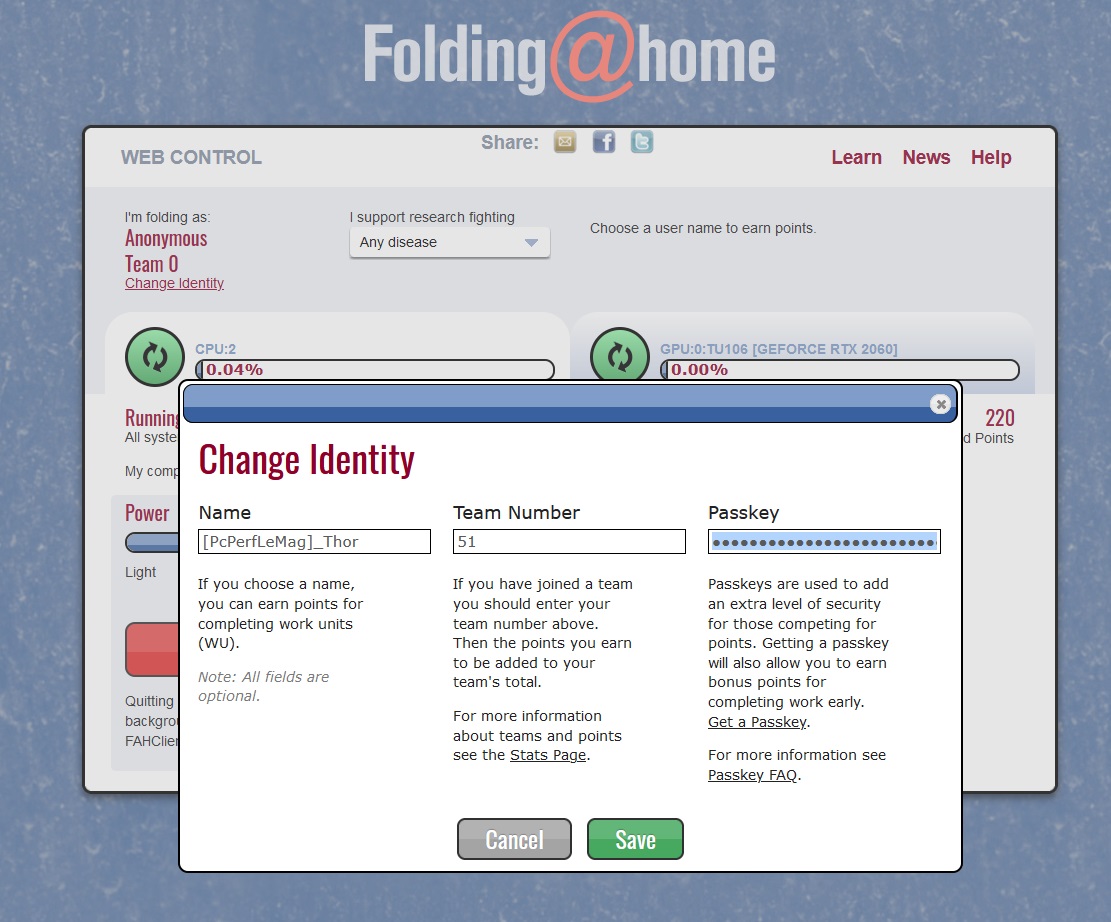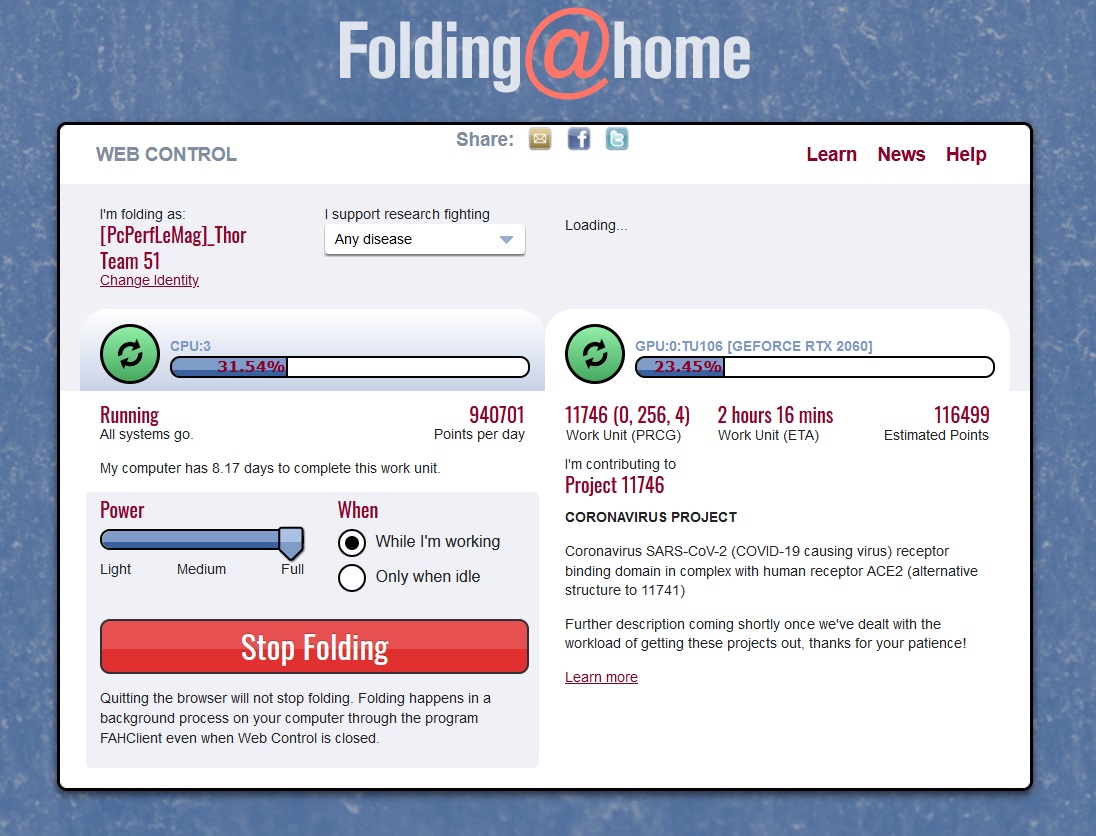-
Compteur de contenus
2 684 -
Inscription
-
Dernière visite
Messages posté(e)s par Thor
-
-
Il y a toujours ce qu'il faut au frais

-
Y'a foule ici aujourd'hui !
-
Salut
Tu t'es perdu ?
?
-
-
Salut Jaques, tu es venus te perdre par ici ?

J'ai bu le plus gros du stock, il ne faudrait pas laisser partir à perte, tu sais bien comment que c'est, mais il reste toujours quelque futs au frais

-
-
Nouvelle mouture des stats avec design remis à neuf grâce aux membres de la Zebteam accessible sur :
https://fah.chezmks.fr/Les stats de la PcPerf team sont ici :
https://fah.chezmks.fr/PcPerf.html

-
Salut pat1ent00

J'avais préparé quelques bières pensant voir quelques retours d'anciens plieurs, mais faute de volontaires j'ai été obligé de tout boire

Quand tu voudras installer Folding, ne soit pas étonné si tu as un message de Windows, le certificat de la toute dernière version est périmé, si l'équipe de F@H se bouge le cul, ça devrait être résolu bientôt, mais de toute manière ça ne gêne pas pour l'installer

-
Tiens, une tête connue

il y a une heure, DK-cahuète a dit :(je sers ≠ je serre)
Bah, on ne se refait pas

-
Advanced controller:
Fenêtre d'information et de paramétrage de Folding at Home accessible en cliquant droit sur l’icône de F@H dans la zone de notification.Calcul distribué:
Client:
Partie du logiciel servant à effectuer les calculs, le logiciel F@H peut piloter parallèlement plusieurs clients, par exemple un client CPU et un client GPU.CPU:
Abréviation pour le processeur principal de l'ordinateur, Central Processor UnitDeadline:
GPU:
Abréviation pour le processeur de la carte ou puce graphique Graphic processor unitF@H:
Abréviation pour parler de Folding at HomeFolding at Home
Protéines
Stanford
Vijay Pande
Web controller
WU:
Work Unit, unité de calcul, chaque client, dès qu'il est lancé, télécharge une WU, en effectue le calcul, puis la renvoie aux serveurs de Stanford avant d'en télécharger une nouvelle. -
Depuis courant 2017, les stats des différents miniteams hébergés sur http://folding.fleucorp.net ne sont plus fonctionnelles.
Pourquoi ? Mystère, malheureusement depuis il semble impossible de reprendre contact avec leur créateur, JGP SOLDAT.En octobre 2017, Kana-chan, un membre de la mini team Zebulon a repris le script des stats que JGP SOLDAT avait mis à disposition des membres de l'AF et a réussi à les remettre en service.
Vous pouvez retrouver ces stats sur https://www.folding.fr/stat/kana/folding/
Les stats de la mini team PcPerf se trouvent là.
-
-
Folding@home update on SARS-CoV-2 (10 Mar 2020)
March 10, 2020by John Chodera
This is an update on Folding@home’s efforts to assist researchers around the world taking up the global fight against COVID-19.
After initial quality control and limited testing phases, Folding@home team has released an initial wave of projects simulating potentially druggable protein targets from SARS-CoV-2 (the virus that causes COVID-19) and the related SARS-CoV virus (for which more structural data is available) into full production on Folding@home. Many thanks to the large number of Folding@home donors who have assisted us thus far by running in beta or advanced modes.
This initial wave of projects focuses on better understanding how these coronaviruses interact with the human ACE2 receptor required for viral entry into human host cells, and how researchers might be able to interfere with them through the design of new therapeutic antibodies or small molecules that might disrupt their interaction.
In the coming days, we hope to take advantage of some of the new structural biology and biochemical data that is being rapidly released by researchers around the world who are working to understand these viruses and strategies for defeating them. This work has been largely disseminated by preprint servers such as bioRxiv and chemRxiv, which aim to make research rapidly available to both other researchers and the public for other scientists to broadly evaluate and immediately start building on. We have also forged several new collaborations with other laboratories where we hope Folding@home will provide valuable support in COVID-19 research efforts.
While we will rapidly release the simulation datasets for others to use or analyze, we aim to look for alternative conformations and hidden pockets within the most promising drug targets, which can only be seen in simulation and not in static X-ray structures. We hope that these structures—once validated by emerging compound screening data—could help direct the virtual screening campaigns or the targeting of new pockets for which atomistic structures were not yet available.
Below, we provide short descriptions of the projects. Note that all input files are being made available on GitHub here for other researchers to take advantage of:
https://github.com/foldingathome/coronavirus
This repository will evolve over the coming days as we add more projects and documentation. We will start posting datasets with structures on publicly available servers as soon as we have useful data to report.
All projects are using the new GPU-accelerated Core22 based on the open source OpenMM biomolecular simulation engine.

SARS-CoV-2 RBD domain in complex with human ACE2 receptor (PDBID: 6vsb, 6acg) [10.1126/science.abb2507, 10.1371/journal.ppat.1007236]11741: Coronavirus SARS-CoV-2 (COVID-19 causing virus) receptor binding domain in complex with human receptor ACE2. atoms: 165550, credit: 15396
11746: Coronavirus SARS-CoV-2 (COVID-19 causing virus) receptor binding domain in complex with human receptor ACE2 (alternative structure to 11741). atoms: 182699, credit: 16615

SARS-CoV-2 main protease in complex with an inhibitor N3 (PDBID: 6lu7) [Not yet published]11742: Coronavirus SARS-CoV-2 (COVID-19 causing virus) protease in complex with an inhibitor. atoms: 62227, credit: 9405
11743: Coronavirus SARS-CoV-2 (COVID-19 causing virus) protease – potential drug target. atoms: 62180, credit: 9405
SARS-CoV-2 RBD domain in complex with human neutralizing S230 antibody Fab fragment (PDBIDs: 6nb7, 6nb8, 2ghv) [ 10.1016/j.cell.2018.12.028 (for both 6nb7 and 6nb8), 10.1074/jbc.M603275200]11744: Coronavirus SARS-CoV (SARS causing virus) receptor binding domain trapped by a SARS-CoV S230 antibody. atoms: 109578, credit: 7608
11745: Coronavirus SARS-CoV (SARS causing virus) receptor binding domain mutated to the SARS-CoV-2 (COVID-19 causing virus) trapped by a SARS-CoV S230 antibody. atoms: 110370, credit: 7685
To contact us to discuss collaborations or data, please email us at foldingathome@choderalab.org
Special thanks to TBCP graduate student Rafal Wiewiora and CBM graduate student Ivy Zhang for their work in modeling these structures from existing experimental data and preparing these projects, and to all the Folding@home donors who help make this work possible!
~ The Chodera lab SARS-CoV-2 team and Folding@home Consortium ~
-
Non, non, pas d'inquiétude, je n'ai pas le coromachin, c'est juste la poussière accumulée qui me fait éternuer.
*Continue d'aligner les verres*
Bon, je serre qui en premier ?
-
Si vous ne vous souvenez plus de votre ancien pseudo, tous les membres ayant contribué sous la bannière de PcPerf sont dans ce fichier.
- Qu'est-ce que le Passkey, comment le retrouver ou en demander un.
Le Passkey est (en théorie) un code unique censé empêcher la triche en empêchant plusieurs personnes d'utiliser le même pseudo.
En pratique, son avantage principal est que si vous retournez régulièrement vos calculs dans les temps, vous aurez un bonus de points

Si vous ne l'avez pas ou plus, vous pouvez en redemander un nouveau sur cette page.
- Les différents réglages.
Dans la fenêtre du web control, l'idéal est de paramétrer la barre "Power" sur "Full" pour un maximum de performance.
Si vous avez des problèmes de surchauffe, vous pouvez passer cette barre sur "Medium" voir "Light" mais bien sûr, les calculs seront plus long.- Le client V7 détecte automatiquement les CPU et GPU pouvant plier.
Cela dit, les GPU sont aujourd’hui beaucoup plus performants et avec un meilleur ratio calcul/consommation électrique que les CPU.
Pour ma part, je ne plie qu’avec mon GPU mais cela dépend de la décision de chacun. Ça peut se configurer en faisant un clic droit sur l'icône folding at Home (
) dans la barre de notification (en bas à droite) et en sélectionnant "Advanced control".
Faites un clic droit sur le client que vous voulez stopper et choisissez "Pause" pour le stopper.
- Pour recevoir des WUs liées au Coronavirus, il faut sélectionner "Any disease" dans "I support research fighting", c'est le paramétrage par défaut.
- Il est possible que votre client est du mal à télécharger de nouvelles WUs, en ce moment, face à l'affluence des nouveaux plieurs, les serveurs de Stanford sont un peu à la peine, il faut simplement être patient et espérer qu'ils renforcent leurs serveurs en début de semaine.
Si vous avez d'autres questions, n'hésitez pas à les poster ci-dessous

-
Bonjour à tous, anciens ou nouveaux plieurs.
Un petit tuto rapide pour l'installation et la configuration du client V7 de folding at home.
- Il faut bien sûr commencer par télécharger la version correspondant à votre système sur le site officiel.
- Une fois téléchargé, un double clic pour lancer l’installateur.
- Une fois l'installation terminée, et le client lancé, cette page va s'ouvrir dans votre navigateur internet. Pour ne pas plier en tant qu'anonyme, sélectionnez "Set up an identity" et cliquez sur "Start Folding".

-
Vous pouvez à présent renseigner votre pseudo (commençant par "[PcPerf]_" pour être automatiquement ajouté à la miniteam PcPerf), le numéro de l'équipe (51) et votre Passkey (optionnel, sert pour le bonus, voir plus bas). Pour composer votre pseudos, faites attention à ne pas utiliser de caractères spéciaux qui pourrait poser problème et contentez vous d'utiliser chiffres, lettres ainsi que les caractères [ ] et _

Félicitation, Folding at home est installé et va commencer à calculer des qu'il aura finit de télécharger sa première WU !


-
-
Coup de gueule: j'étais gris pendant trop longtemps

Coup de cœur: Aujourd'hui je suis repassé noir


Je risque de redevenir gris ces jours ci, mais je comptes me remettre vraiment à plier d'ici quelque temps

-
Comme dit ailleurs, je comptes bientôt m'y remettre et donner un petit coup de main à foo_fight dans la miniteam, même si ça va être une goutte d'eau vu ses ppd journalier

-
Je viens de doucement m'y remettre et au passage j'ai eu une bonne surprise en voyant qu'avec le nouveau client, le client Gpu ce met en idle quand l'ordi est utilisé pour éviter que ça rames.
-
carte graphique
dans Hardware
Salut et bonne année à tous les deux

Par contre désolé mais je n'ai pas non plus de réponse à ta question Cyb

-
Plus qu'environ 5000 avant de te rattraper

-
Il faut voir le bon coté des choses, ça fait plus à boire pour chacun, santé !


-
Salut ol' rem
Ca va faire du bien, la team est au ralentis ces temps ci.


Archives du mag PcPerf
dans le foldingueur assoiffé
Posté(e) · Signaler la réponse
Cool !
J'en ai d'autres qu'il faut que je me motive à scanner... un de ces jours